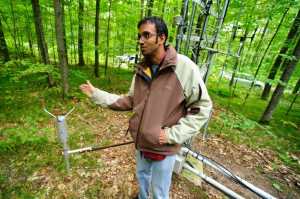John Tolley, August 1, 2018
To the layperson, weather is largely a mysterious force of nature. It is an immutable reality that can, at best, be prepared for. But meteorologists know well that weather is a turbulent combination of many factors, from the energy of the sun falling on the planet to humanity?s chemical output and our constructs of steel, concrete, glass and asphalt. As air heats and cools and gathers moisture at one point and expels it at another, the whole of the world, natural and manmade, comes to bear.
At the University of Wisconsin-Madison, an ambitious project set to launch in 2019 will look into what role exactly plants and trees have in effecting and regulating the weather. The Chequamegon Heterogenous Ecosystem Energy-balanced Study Enabled by a High-density Extensive Array of Detectors 2019 (mercifully known as CHEESEHEAD19) covers a 10 km by 10 km patch of the Chequamegon-Nicolet National Forest in northern Wisconsin, an area researchers hope will give them a detailed picture how flora of all stripes exert influence on atmospheric conditions.
Aiding the researchers will be an arsenal of high-tech tools for measuring the panoply of factors incumbent to the study. That arsenal includes three aircraft (a turbo-prop plane, an ultralight and a Cessna on loan from the state,) ground-based instruments and network of sky-scraping towers collecting data on temperature, humidity and greenhouse gas levels.

What study leader Ankur Desai, a professor of atmospheric and oceanic sciences at Wisconsin, hopes to see is how the ability of plants to cycle both gases and water in and out of the atmosphere effects local cloud formation and weather patterns. This is important, said Desai speaking with the UW-Madison news service, because current maps and models generally deal with weather on a large-scale.
This could vastly improve how weather and climate models are created, Desai added, as more granularity could be added based on what is known of the vegetation in a certain area.
While CHEESEHEAD19 won?t launch until next year, funding has already been secured in the form of a $1.5 million grant from the National Science Foundation, with a matching grant to cover the cost of purchasing, constructing and maintaining the various instruments for the study.
To learn more about CHEESEHEAD19, Desai?s previous work in the Chequamegon Forest and the instruments being used to track the date, check out the full story here.







